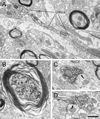The inhibitory influence of the lateral habenula on midbrain dopamine cells: ultrastructural evidence for indirect mediation via the rostromedial mesopontine tegmental nucleus
- PMID: 21344406
- PMCID: PMC4054696
- DOI: 10.1002/cne.22561
The inhibitory influence of the lateral habenula on midbrain dopamine cells: ultrastructural evidence for indirect mediation via the rostromedial mesopontine tegmental nucleus
Abstract
The lateral habenula (LHb) provides an important source of negative reinforcement signals to midbrain dopamine (DA) cells in the substantia nigra and ventral tegmental area (VTA). This profound and consistent inhibitory influence involves a disynaptic connection from glutamate neurons in the LHb to some population of γ-aminobutyric acid (GABA) cells that, in turn, innervates DA neurons. Previous studies demonstrated that the GABA cells intrinsic to the VTA receive insufficient synaptic input from the LHb to serve as the primary source of this intermediate connection. In this investigation, we sought ultrastructural evidence supporting the hypothesis that a newly identified region of the brainstem, the rostromedial mesopontine tegmental nucleus (RMTg), is a more likely candidate for inhibiting midbrain DA cells in response to LHb activation. Electron microscopic examination of rat brain sections containing dual immunoreactivity for an anterograde tracing agent and a phenotypic marker revealed that: 1) more than 55% of the synapses formed by LHb axons in the RMTg were onto GABA-labeled dendrites; 2) more than 80% of the synapses formed by RMTg axons in the VTA contacted dendrites immunoreactive for the DA synthetic enzyme tyrosine hydroxylase; and 3) nearly all RMTg axons formed symmetric synapses and contained postembedding immunoreactivity for GABA. These findings indicate that the newly identified RMTg region is an intermediate structure in a disynaptic pathway that connects the LHb to VTA DA neurons. The results have important implications for understanding mental disorders characterized by a dysregulation of reward circuitry involving LHb and DA cell populations.
Copyright © 2011 Wiley-Liss, Inc.
Figures










References
-
- Aizawa H, Isomura Y, Kobayashi M, Harukuni R, Tanaka S, Fukai T, Okamoto H. Heterogeneity of the lateral habenular neurons revealed by gene expression. Soc Neurosci Abstr. 2008:490.492.
-
- Amat J, Sparks PD, Matus-Amat P, Griggs J, Watkins LR, Maier SF. The role of the habenular complex in the elevation of dorsal raphe nucleus serotonin and the changes in the behavioral responses produced by uncontrollable stress. Brain Res. 2001;917:118–126. - PubMed
-
- Araki M, McGeer PL, Kimura H. The efferent projections of the rat lateral habenular nucleus revealed by the PHA-L anterograde tracing method. Brain Res. 1988;441:319–330. - PubMed
-
- Balcita-Pedicino JJ, Sesack SR. Orexin axons in the rat ventral tegmental area synapse infrequently onto dopamine and gamma-aminobutyric acid neurons. J Comp Neurol. 2007;503:668–684. - PubMed
-
- Balcita-Pedicino JJ, Omelchenko N, Bell R, Sesack SR. The rostromedial mesopontine tegmentum as a relay between the lateral habenula and dopamine neurons in the ventral tegmental area: ultrastructural evidence in the rat. Soc Neurosci Abstr. 2009:815.817.
Publication types
MeSH terms
Substances
Grants and funding
LinkOut - more resources
Full Text Sources

